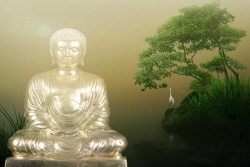Satta Bojjhaṅgā
The Seven Factors of Awakening (Satta Bojjhaṅgā)
One of the central and most important developmental sequences of the path is indicated by the seven factors of awakening. This sequence of mental factors illustrates how — beginning with mindfulness — we can progressively cultivate skillful mental qualities which lead up to and eventually culminate in meditative composure. These seven factors of awakening are mindfulness (sati), dhamma-investigation (dhammavicaya), energy (vīriya), joy (pīti), tranquility (passaddhi), meditative composure (samādhi), and equanimity (upekkhā).
A mind that is pliant and adaptable has the capacity to discover the freedom of awakening. And it is mindfulness that assists us in being fully present and aware. When mindfulness occurs together with full awareness it is non-reactive and inclusive. This combination of mindfulness and full awareness arises through a volitional choice to be attentive to whatever objects present themselves to awareness as an open, ongoing process, without getting caught up and held captive by habitual reactions.
However, although mindfulness is a mental quality that we can allow to arise, and even learn to refine, somewhat paradoxically, it isn’t something that we can forcefully control. Rather, we train the mind by recognizing the benefits and usefulness of mindfulness when it is present, and becoming accustomed to sustaining this quality of flexible, clear awareness. Therefore, this training is experiential. We have to experience and recognize it for ourselves as it is occurring.
With mindfulness and full awareness, we can further investigate our immediate experience in terms of the four applications of mindfulness, which provide our practice with a foundation to help orient us, and the four exertions, which assist us to train in the development and maintenance of skillful qualities and the abandonment of unskillful ones. These activities are aspects of dhamma-investigation.
As we develop some appreciation for these modes of mental engagement, and become accustomed to sustaining dhamma-investigation, this generates balanced enthusiasm and refined levels of energy that occur due to experiencing the flexibility of mental clarity. Attention and energy allow the mind to remain clear and stable without getting lost in the content of associated thoughts and memories. This developmental process is described in SN 46.3 Sīlasutta:
Abiding thus withdrawn, one recollects that dhamma and thinks it over. Whenever, monks, a monk abiding thus withdrawn recollects that dhamma and thinks it over, on that occasion the awakening factor of mindfulness is aroused by the monk, on that occasion the monk develops the awakening factor of mindfulness, on that occasion the awakening factor of mindfulness comes to fulfillment through development in the monk.
Abiding thus mindfully, he discriminates that dhamma with discernment, examines it, makes an investigation of it. Whenever, monks, a monk dwelling thus mindfully discriminates that dhamma with discernment, examines it, makes an investigation of it, on that occasion the awakening factor of dhamma-investigation is aroused by the monk, on that occasion the monk develops the awakening factor of dhamma-investigation, on that occasion the awakening factor of dhamma-investigation comes to fulfillment through development in the monk.
While he discriminates that dhamma with discernment, examines it, makes an investigation of it, his energy is aroused without slackening. Whenever, monks, a monk’s energy is aroused without slackening as he discriminates that dhamma with discernment, examines it, makes an investigation of it, on that occasion the awakening factor of energy is aroused by the monk, on that occasion the monk develops the awakening factor of energy, on that occasion the awakening factor of energy comes to fulfillment through development in the monk.
At this stage mindfulness can seem to occur effortlessly for extended periods of time. The mind and body feel light and exuberant. The joy and pleasure of simply being present arise, and we can learn to recognize and accustom ourselves to this experience as it occurs. Again, this is a natural process that arises when the conditions are appropriate, and is not effectively engendered by attempting to force the mind to be a certain way. SN 46.3 continues:
When his energy is aroused, there arises in him non-carnal joy. Whenever, monks, non-carnal joy arises in a monk whose energy is aroused, on that occasion the awakening factor of joy is aroused by the monk, on that occasion the monk develops the awakening factor of joy, on that occasion the awakening factor of joy comes to fulfillment through development in the monk.
The onset of mental joy prepares the way for the arising of the remaining factors of awakening and the occurrence of meditative composure. SN 46.3 gives a good overview of these factors, which we will begin to explore in greater detail on the next page:
For one whose mind is uplifted by joy the body becomes tranquil and the mind becomes tranquil. Whenever, monks, the body becomes tranquil and the mind becomes tranquil in a monk whose mind is uplifted by joy, on that occasion the awakening factor of tranquility is aroused by the monk, on that occasion the monk develops the awakening factor of tranquility, on that occasion the awakening factor of tranquility comes to fulfillment through development in the monk.
For one whose body is tranquil and who is happy the mind becomes composed. Whenever, monks, the mind becomes composed in a monk whose body is tranquil and who is happy, on that occasion the awakening factor of meditative composure is aroused by the monk, on that occasion the monk develops the awakening factor of meditative composure, on that occasion the awakening factor of meditative composure comes to fulfillment through development in the monk.
He closely looks on with equanimity at the mind thus composed. Whenever, monks, a monk closely looks on with equanimity at the mind thus composed, on that occasion the awakening factor of equanimity is aroused by the monk, on that occasion the monk develops the awakening factor of equanimity, on that occasion the awakening factor of equanimity comes to fulfillment through development in the monk.
For some people these factors can arise fairly quickly. For others, this training process can take longer. But it’s important to keep in mind that this is a natural process of mental development, and will occur when the conditions are conducive for this refined level of development. It’s also important to understand that the purpose of this developmental process is not to stop the mind from functioning, but to train the mind to function with greater clarity and more subtle awareness. This is why this practice is included in the training in heightened mind (adhicittasikkhā).
see also; Seven elements for enlightenment



